Project Management Leadership Self-Reflection Report: BUSM1282
VerifiedAdded on 2023/04/23
|9
|2442
|88
Report
AI Summary
This self-reflection report examines the concept of leadership within project management, focusing on the author's personal journey and professional practice. It begins by defining leadership in the context of project management, emphasizing the application of project management guidelines to achieve project objectives. The report then delves into a SWOT analysis, highlighting strengths such as team collaboration, communication, and emotional intelligence, while also identifying weaknesses in risk management, technical skills, and creative analysis. Short-term and long-term action plans are developed to address these areas, with specific goals, timelines, and activities aimed at improving risk management and fostering creative analytical skills, with a focus on adopting a transformational leadership style. The report concludes by emphasizing the ongoing nature of leadership development and the importance of continuous self-reflection to enhance skills and achieve project success. The author plans to integrate project management concepts with leadership styles to be successful.
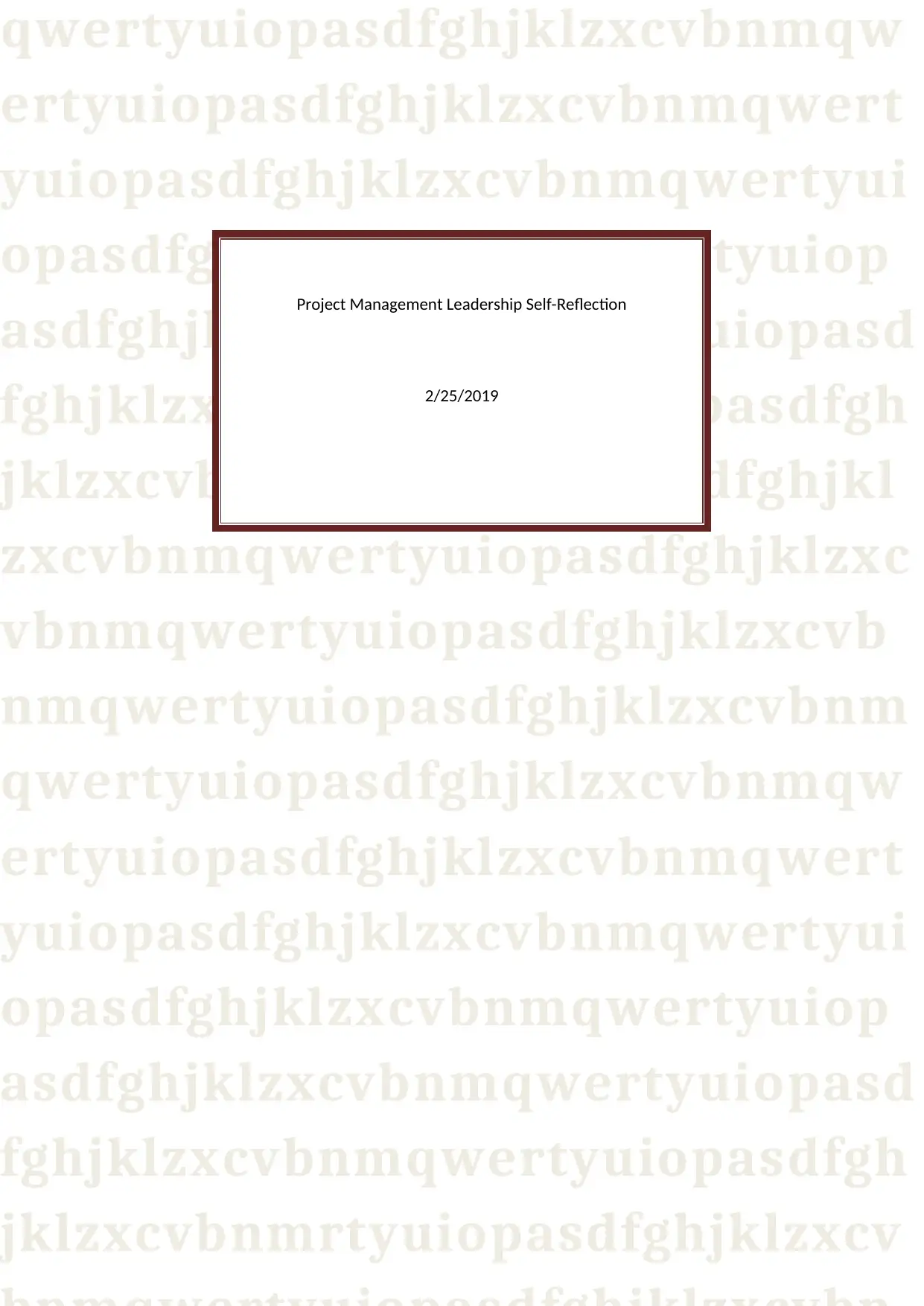
qwertyuiopasdfghjklzxcvbnmqw
ertyuiopasdfghjklzxcvbnmqwert
yuiopasdfghjklzxcvbnmqwertyui
opasdfghjklzxcvbnmqwertyuiop
asdfghjklzxcvbnmqwertyuiopasd
fghjklzxcvbnmqwertyuiopasdfgh
jklzxcvbnmqwertyuiopasdfghjkl
zxcvbnmqwertyuiopasdfghjklzxc
vbnmqwertyuiopasdfghjklzxcvb
nmqwertyuiopasdfghjklzxcvbnm
qwertyuiopasdfghjklzxcvbnmqw
ertyuiopasdfghjklzxcvbnmqwert
yuiopasdfghjklzxcvbnmqwertyui
opasdfghjklzxcvbnmqwertyuiop
asdfghjklzxcvbnmqwertyuiopasd
fghjklzxcvbnmqwertyuiopasdfgh
jklzxcvbnmrtyuiopasdfghjklzxcv
Project Management Leadership Self-Reflection
2/25/2019
ertyuiopasdfghjklzxcvbnmqwert
yuiopasdfghjklzxcvbnmqwertyui
opasdfghjklzxcvbnmqwertyuiop
asdfghjklzxcvbnmqwertyuiopasd
fghjklzxcvbnmqwertyuiopasdfgh
jklzxcvbnmqwertyuiopasdfghjkl
zxcvbnmqwertyuiopasdfghjklzxc
vbnmqwertyuiopasdfghjklzxcvb
nmqwertyuiopasdfghjklzxcvbnm
qwertyuiopasdfghjklzxcvbnmqw
ertyuiopasdfghjklzxcvbnmqwert
yuiopasdfghjklzxcvbnmqwertyui
opasdfghjklzxcvbnmqwertyuiop
asdfghjklzxcvbnmqwertyuiopasd
fghjklzxcvbnmqwertyuiopasdfgh
jklzxcvbnmrtyuiopasdfghjklzxcv
Project Management Leadership Self-Reflection
2/25/2019
Paraphrase This Document
Need a fresh take? Get an instant paraphrase of this document with our AI Paraphraser
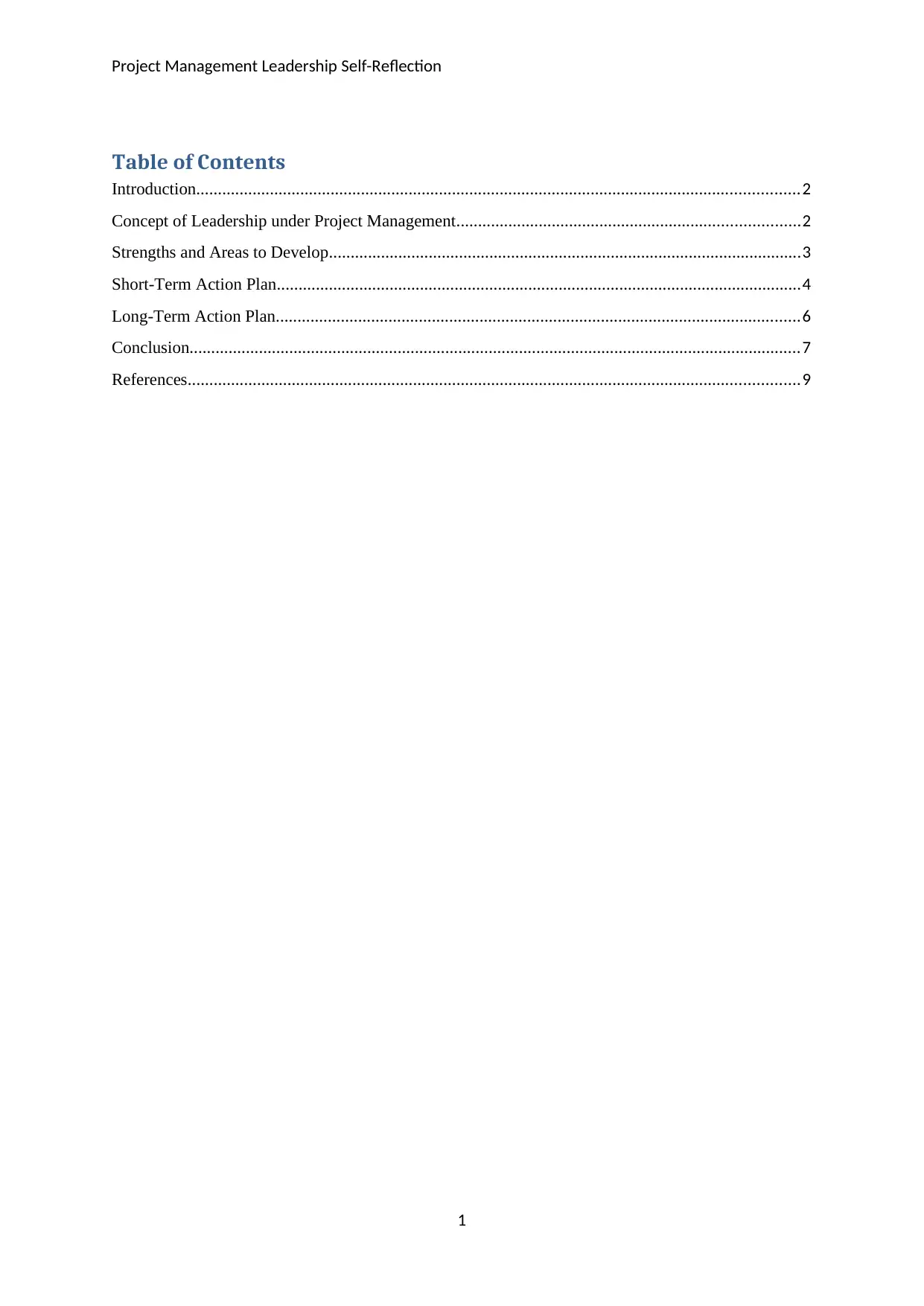
Project Management Leadership Self-Reflection
Table of Contents
Introduction...........................................................................................................................................2
Concept of Leadership under Project Management...............................................................................2
Strengths and Areas to Develop.............................................................................................................3
Short-Term Action Plan.........................................................................................................................4
Long-Term Action Plan.........................................................................................................................6
Conclusion.............................................................................................................................................7
References.............................................................................................................................................9
1
Table of Contents
Introduction...........................................................................................................................................2
Concept of Leadership under Project Management...............................................................................2
Strengths and Areas to Develop.............................................................................................................3
Short-Term Action Plan.........................................................................................................................4
Long-Term Action Plan.........................................................................................................................6
Conclusion.............................................................................................................................................7
References.............................................................................................................................................9
1
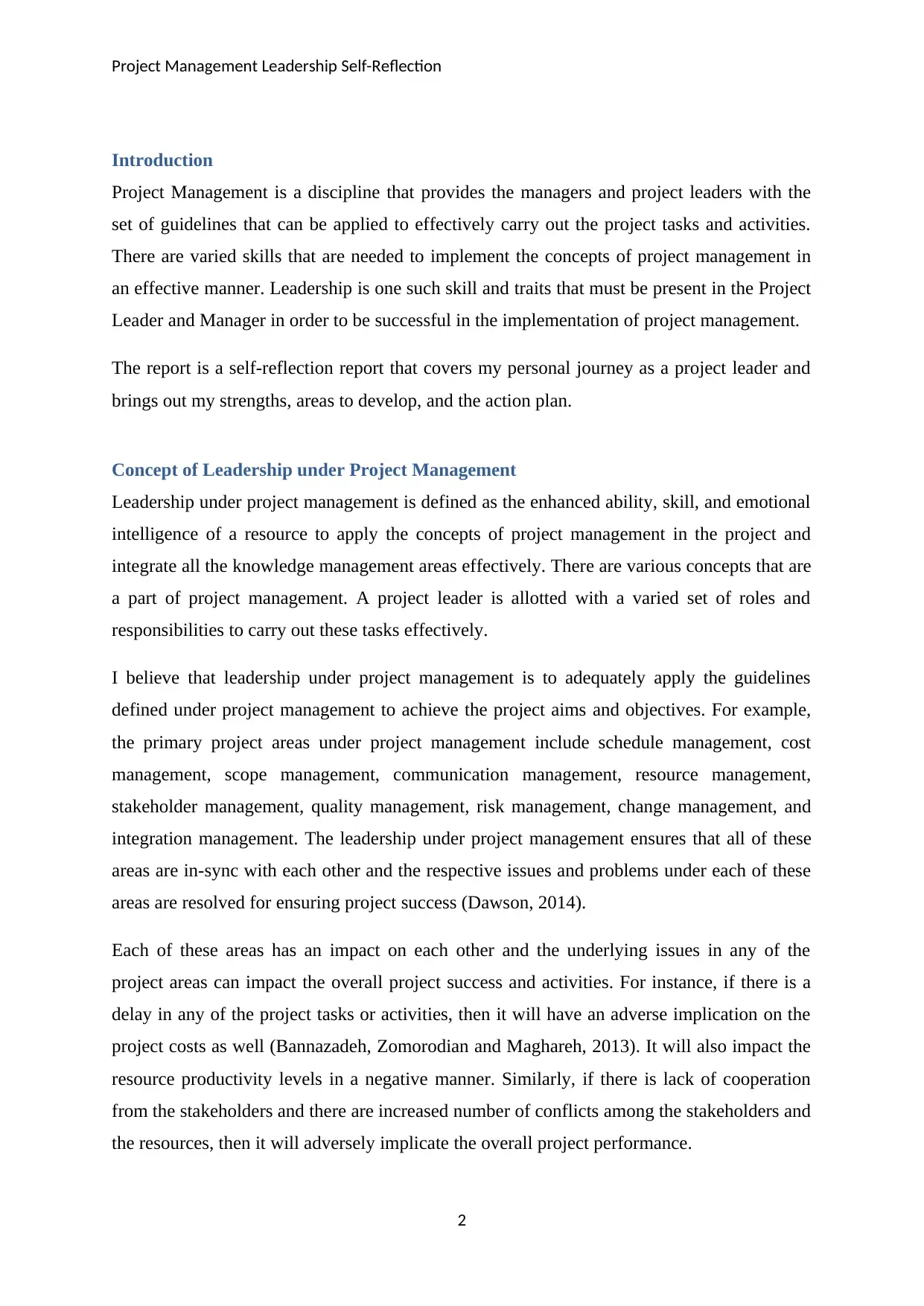
Project Management Leadership Self-Reflection
Introduction
Project Management is a discipline that provides the managers and project leaders with the
set of guidelines that can be applied to effectively carry out the project tasks and activities.
There are varied skills that are needed to implement the concepts of project management in
an effective manner. Leadership is one such skill and traits that must be present in the Project
Leader and Manager in order to be successful in the implementation of project management.
The report is a self-reflection report that covers my personal journey as a project leader and
brings out my strengths, areas to develop, and the action plan.
Concept of Leadership under Project Management
Leadership under project management is defined as the enhanced ability, skill, and emotional
intelligence of a resource to apply the concepts of project management in the project and
integrate all the knowledge management areas effectively. There are various concepts that are
a part of project management. A project leader is allotted with a varied set of roles and
responsibilities to carry out these tasks effectively.
I believe that leadership under project management is to adequately apply the guidelines
defined under project management to achieve the project aims and objectives. For example,
the primary project areas under project management include schedule management, cost
management, scope management, communication management, resource management,
stakeholder management, quality management, risk management, change management, and
integration management. The leadership under project management ensures that all of these
areas are in-sync with each other and the respective issues and problems under each of these
areas are resolved for ensuring project success (Dawson, 2014).
Each of these areas has an impact on each other and the underlying issues in any of the
project areas can impact the overall project success and activities. For instance, if there is a
delay in any of the project tasks or activities, then it will have an adverse implication on the
project costs as well (Bannazadeh, Zomorodian and Maghareh, 2013). It will also impact the
resource productivity levels in a negative manner. Similarly, if there is lack of cooperation
from the stakeholders and there are increased number of conflicts among the stakeholders and
the resources, then it will adversely implicate the overall project performance.
2
Introduction
Project Management is a discipline that provides the managers and project leaders with the
set of guidelines that can be applied to effectively carry out the project tasks and activities.
There are varied skills that are needed to implement the concepts of project management in
an effective manner. Leadership is one such skill and traits that must be present in the Project
Leader and Manager in order to be successful in the implementation of project management.
The report is a self-reflection report that covers my personal journey as a project leader and
brings out my strengths, areas to develop, and the action plan.
Concept of Leadership under Project Management
Leadership under project management is defined as the enhanced ability, skill, and emotional
intelligence of a resource to apply the concepts of project management in the project and
integrate all the knowledge management areas effectively. There are various concepts that are
a part of project management. A project leader is allotted with a varied set of roles and
responsibilities to carry out these tasks effectively.
I believe that leadership under project management is to adequately apply the guidelines
defined under project management to achieve the project aims and objectives. For example,
the primary project areas under project management include schedule management, cost
management, scope management, communication management, resource management,
stakeholder management, quality management, risk management, change management, and
integration management. The leadership under project management ensures that all of these
areas are in-sync with each other and the respective issues and problems under each of these
areas are resolved for ensuring project success (Dawson, 2014).
Each of these areas has an impact on each other and the underlying issues in any of the
project areas can impact the overall project success and activities. For instance, if there is a
delay in any of the project tasks or activities, then it will have an adverse implication on the
project costs as well (Bannazadeh, Zomorodian and Maghareh, 2013). It will also impact the
resource productivity levels in a negative manner. Similarly, if there is lack of cooperation
from the stakeholders and there are increased number of conflicts among the stakeholders and
the resources, then it will adversely implicate the overall project performance.
2
⊘ This is a preview!⊘
Do you want full access?
Subscribe today to unlock all pages.

Trusted by 1+ million students worldwide
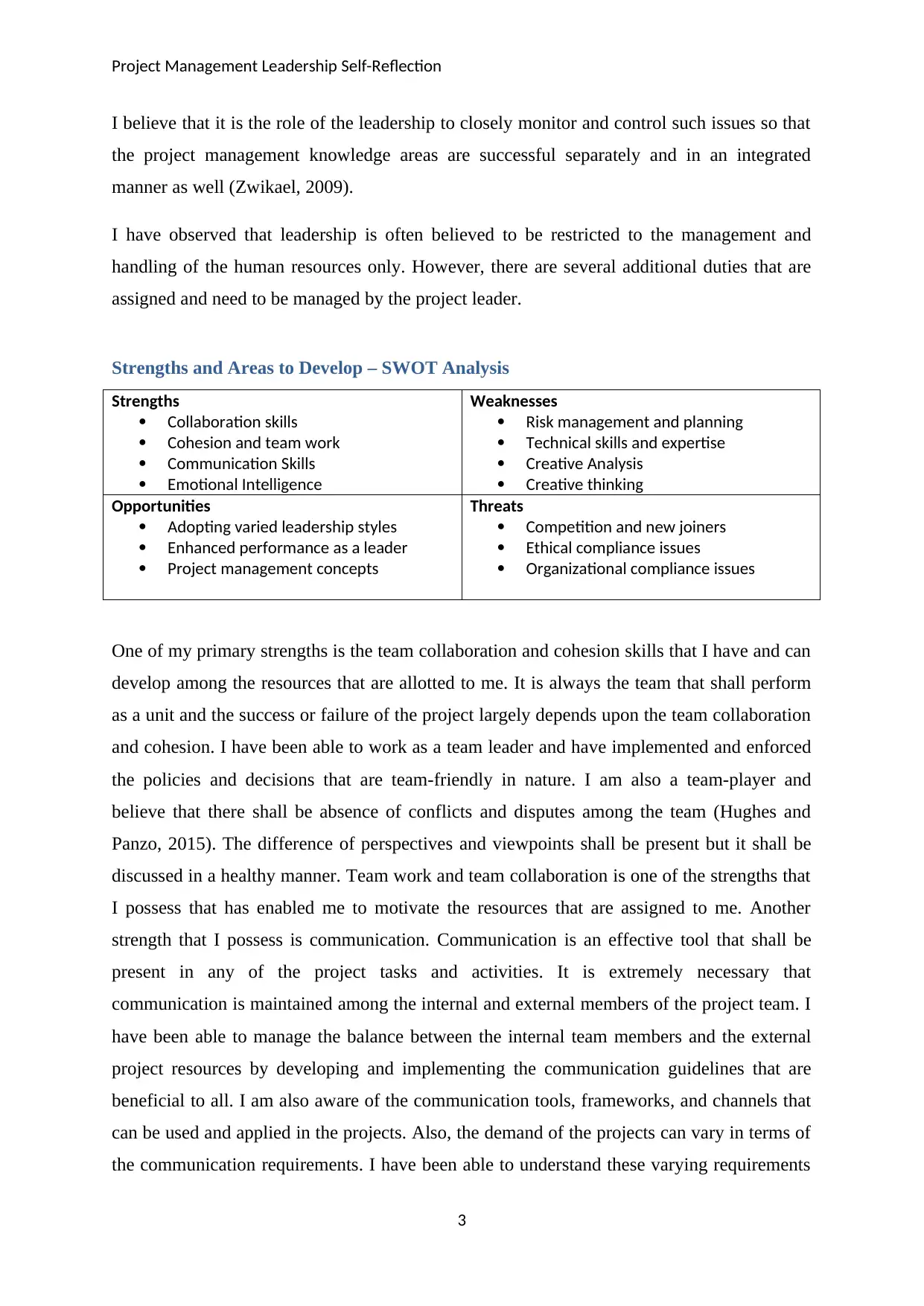
Project Management Leadership Self-Reflection
I believe that it is the role of the leadership to closely monitor and control such issues so that
the project management knowledge areas are successful separately and in an integrated
manner as well (Zwikael, 2009).
I have observed that leadership is often believed to be restricted to the management and
handling of the human resources only. However, there are several additional duties that are
assigned and need to be managed by the project leader.
Strengths and Areas to Develop – SWOT Analysis
Strengths
Collaboration skills
Cohesion and team work
Communication Skills
Emotional Intelligence
Weaknesses
Risk management and planning
Technical skills and expertise
Creative Analysis
Creative thinking
Opportunities
Adopting varied leadership styles
Enhanced performance as a leader
Project management concepts
Threats
Competition and new joiners
Ethical compliance issues
Organizational compliance issues
One of my primary strengths is the team collaboration and cohesion skills that I have and can
develop among the resources that are allotted to me. It is always the team that shall perform
as a unit and the success or failure of the project largely depends upon the team collaboration
and cohesion. I have been able to work as a team leader and have implemented and enforced
the policies and decisions that are team-friendly in nature. I am also a team-player and
believe that there shall be absence of conflicts and disputes among the team (Hughes and
Panzo, 2015). The difference of perspectives and viewpoints shall be present but it shall be
discussed in a healthy manner. Team work and team collaboration is one of the strengths that
I possess that has enabled me to motivate the resources that are assigned to me. Another
strength that I possess is communication. Communication is an effective tool that shall be
present in any of the project tasks and activities. It is extremely necessary that
communication is maintained among the internal and external members of the project team. I
have been able to manage the balance between the internal team members and the external
project resources by developing and implementing the communication guidelines that are
beneficial to all. I am also aware of the communication tools, frameworks, and channels that
can be used and applied in the projects. Also, the demand of the projects can vary in terms of
the communication requirements. I have been able to understand these varying requirements
3
I believe that it is the role of the leadership to closely monitor and control such issues so that
the project management knowledge areas are successful separately and in an integrated
manner as well (Zwikael, 2009).
I have observed that leadership is often believed to be restricted to the management and
handling of the human resources only. However, there are several additional duties that are
assigned and need to be managed by the project leader.
Strengths and Areas to Develop – SWOT Analysis
Strengths
Collaboration skills
Cohesion and team work
Communication Skills
Emotional Intelligence
Weaknesses
Risk management and planning
Technical skills and expertise
Creative Analysis
Creative thinking
Opportunities
Adopting varied leadership styles
Enhanced performance as a leader
Project management concepts
Threats
Competition and new joiners
Ethical compliance issues
Organizational compliance issues
One of my primary strengths is the team collaboration and cohesion skills that I have and can
develop among the resources that are allotted to me. It is always the team that shall perform
as a unit and the success or failure of the project largely depends upon the team collaboration
and cohesion. I have been able to work as a team leader and have implemented and enforced
the policies and decisions that are team-friendly in nature. I am also a team-player and
believe that there shall be absence of conflicts and disputes among the team (Hughes and
Panzo, 2015). The difference of perspectives and viewpoints shall be present but it shall be
discussed in a healthy manner. Team work and team collaboration is one of the strengths that
I possess that has enabled me to motivate the resources that are assigned to me. Another
strength that I possess is communication. Communication is an effective tool that shall be
present in any of the project tasks and activities. It is extremely necessary that
communication is maintained among the internal and external members of the project team. I
have been able to manage the balance between the internal team members and the external
project resources by developing and implementing the communication guidelines that are
beneficial to all. I am also aware of the communication tools, frameworks, and channels that
can be used and applied in the projects. Also, the demand of the projects can vary in terms of
the communication requirements. I have been able to understand these varying requirements
3
Paraphrase This Document
Need a fresh take? Get an instant paraphrase of this document with our AI Paraphraser
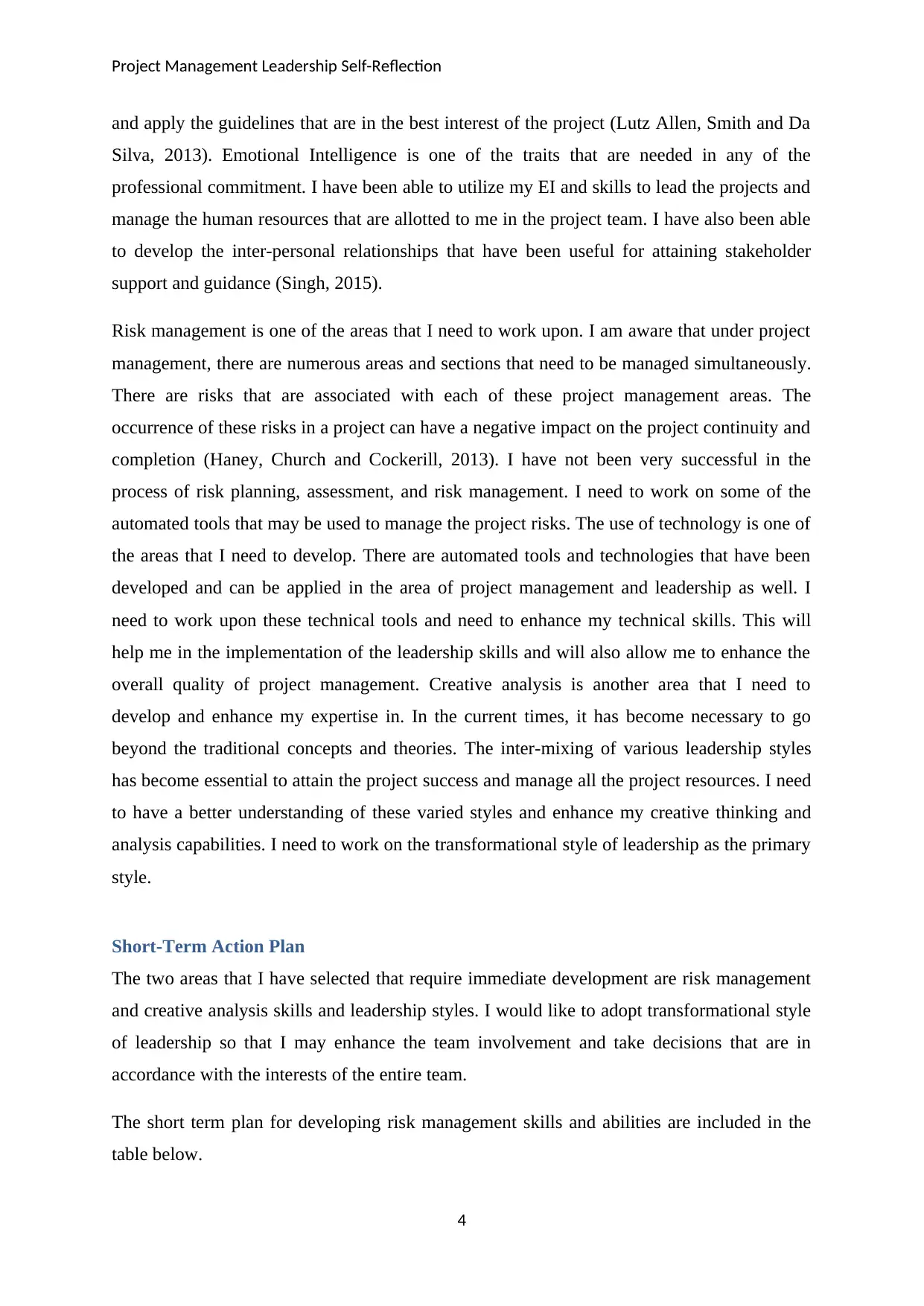
Project Management Leadership Self-Reflection
and apply the guidelines that are in the best interest of the project (Lutz Allen, Smith and Da
Silva, 2013). Emotional Intelligence is one of the traits that are needed in any of the
professional commitment. I have been able to utilize my EI and skills to lead the projects and
manage the human resources that are allotted to me in the project team. I have also been able
to develop the inter-personal relationships that have been useful for attaining stakeholder
support and guidance (Singh, 2015).
Risk management is one of the areas that I need to work upon. I am aware that under project
management, there are numerous areas and sections that need to be managed simultaneously.
There are risks that are associated with each of these project management areas. The
occurrence of these risks in a project can have a negative impact on the project continuity and
completion (Haney, Church and Cockerill, 2013). I have not been very successful in the
process of risk planning, assessment, and risk management. I need to work on some of the
automated tools that may be used to manage the project risks. The use of technology is one of
the areas that I need to develop. There are automated tools and technologies that have been
developed and can be applied in the area of project management and leadership as well. I
need to work upon these technical tools and need to enhance my technical skills. This will
help me in the implementation of the leadership skills and will also allow me to enhance the
overall quality of project management. Creative analysis is another area that I need to
develop and enhance my expertise in. In the current times, it has become necessary to go
beyond the traditional concepts and theories. The inter-mixing of various leadership styles
has become essential to attain the project success and manage all the project resources. I need
to have a better understanding of these varied styles and enhance my creative thinking and
analysis capabilities. I need to work on the transformational style of leadership as the primary
style.
Short-Term Action Plan
The two areas that I have selected that require immediate development are risk management
and creative analysis skills and leadership styles. I would like to adopt transformational style
of leadership so that I may enhance the team involvement and take decisions that are in
accordance with the interests of the entire team.
The short term plan for developing risk management skills and abilities are included in the
table below.
4
and apply the guidelines that are in the best interest of the project (Lutz Allen, Smith and Da
Silva, 2013). Emotional Intelligence is one of the traits that are needed in any of the
professional commitment. I have been able to utilize my EI and skills to lead the projects and
manage the human resources that are allotted to me in the project team. I have also been able
to develop the inter-personal relationships that have been useful for attaining stakeholder
support and guidance (Singh, 2015).
Risk management is one of the areas that I need to work upon. I am aware that under project
management, there are numerous areas and sections that need to be managed simultaneously.
There are risks that are associated with each of these project management areas. The
occurrence of these risks in a project can have a negative impact on the project continuity and
completion (Haney, Church and Cockerill, 2013). I have not been very successful in the
process of risk planning, assessment, and risk management. I need to work on some of the
automated tools that may be used to manage the project risks. The use of technology is one of
the areas that I need to develop. There are automated tools and technologies that have been
developed and can be applied in the area of project management and leadership as well. I
need to work upon these technical tools and need to enhance my technical skills. This will
help me in the implementation of the leadership skills and will also allow me to enhance the
overall quality of project management. Creative analysis is another area that I need to
develop and enhance my expertise in. In the current times, it has become necessary to go
beyond the traditional concepts and theories. The inter-mixing of various leadership styles
has become essential to attain the project success and manage all the project resources. I need
to have a better understanding of these varied styles and enhance my creative thinking and
analysis capabilities. I need to work on the transformational style of leadership as the primary
style.
Short-Term Action Plan
The two areas that I have selected that require immediate development are risk management
and creative analysis skills and leadership styles. I would like to adopt transformational style
of leadership so that I may enhance the team involvement and take decisions that are in
accordance with the interests of the entire team.
The short term plan for developing risk management skills and abilities are included in the
table below.
4
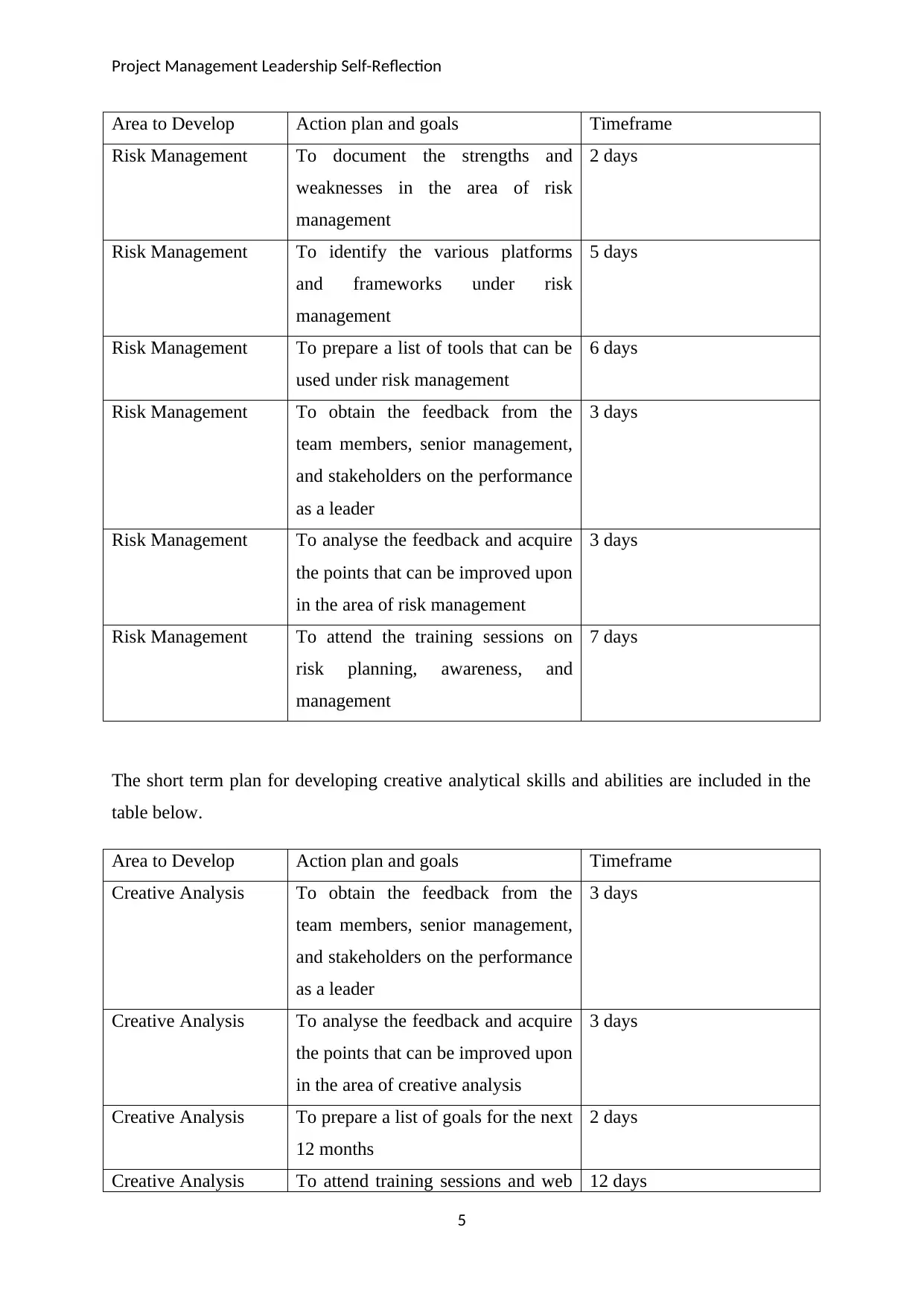
Project Management Leadership Self-Reflection
Area to Develop Action plan and goals Timeframe
Risk Management To document the strengths and
weaknesses in the area of risk
management
2 days
Risk Management To identify the various platforms
and frameworks under risk
management
5 days
Risk Management To prepare a list of tools that can be
used under risk management
6 days
Risk Management To obtain the feedback from the
team members, senior management,
and stakeholders on the performance
as a leader
3 days
Risk Management To analyse the feedback and acquire
the points that can be improved upon
in the area of risk management
3 days
Risk Management To attend the training sessions on
risk planning, awareness, and
management
7 days
The short term plan for developing creative analytical skills and abilities are included in the
table below.
Area to Develop Action plan and goals Timeframe
Creative Analysis To obtain the feedback from the
team members, senior management,
and stakeholders on the performance
as a leader
3 days
Creative Analysis To analyse the feedback and acquire
the points that can be improved upon
in the area of creative analysis
3 days
Creative Analysis To prepare a list of goals for the next
12 months
2 days
Creative Analysis To attend training sessions and web 12 days
5
Area to Develop Action plan and goals Timeframe
Risk Management To document the strengths and
weaknesses in the area of risk
management
2 days
Risk Management To identify the various platforms
and frameworks under risk
management
5 days
Risk Management To prepare a list of tools that can be
used under risk management
6 days
Risk Management To obtain the feedback from the
team members, senior management,
and stakeholders on the performance
as a leader
3 days
Risk Management To analyse the feedback and acquire
the points that can be improved upon
in the area of risk management
3 days
Risk Management To attend the training sessions on
risk planning, awareness, and
management
7 days
The short term plan for developing creative analytical skills and abilities are included in the
table below.
Area to Develop Action plan and goals Timeframe
Creative Analysis To obtain the feedback from the
team members, senior management,
and stakeholders on the performance
as a leader
3 days
Creative Analysis To analyse the feedback and acquire
the points that can be improved upon
in the area of creative analysis
3 days
Creative Analysis To prepare a list of goals for the next
12 months
2 days
Creative Analysis To attend training sessions and web 12 days
5
⊘ This is a preview!⊘
Do you want full access?
Subscribe today to unlock all pages.

Trusted by 1+ million students worldwide
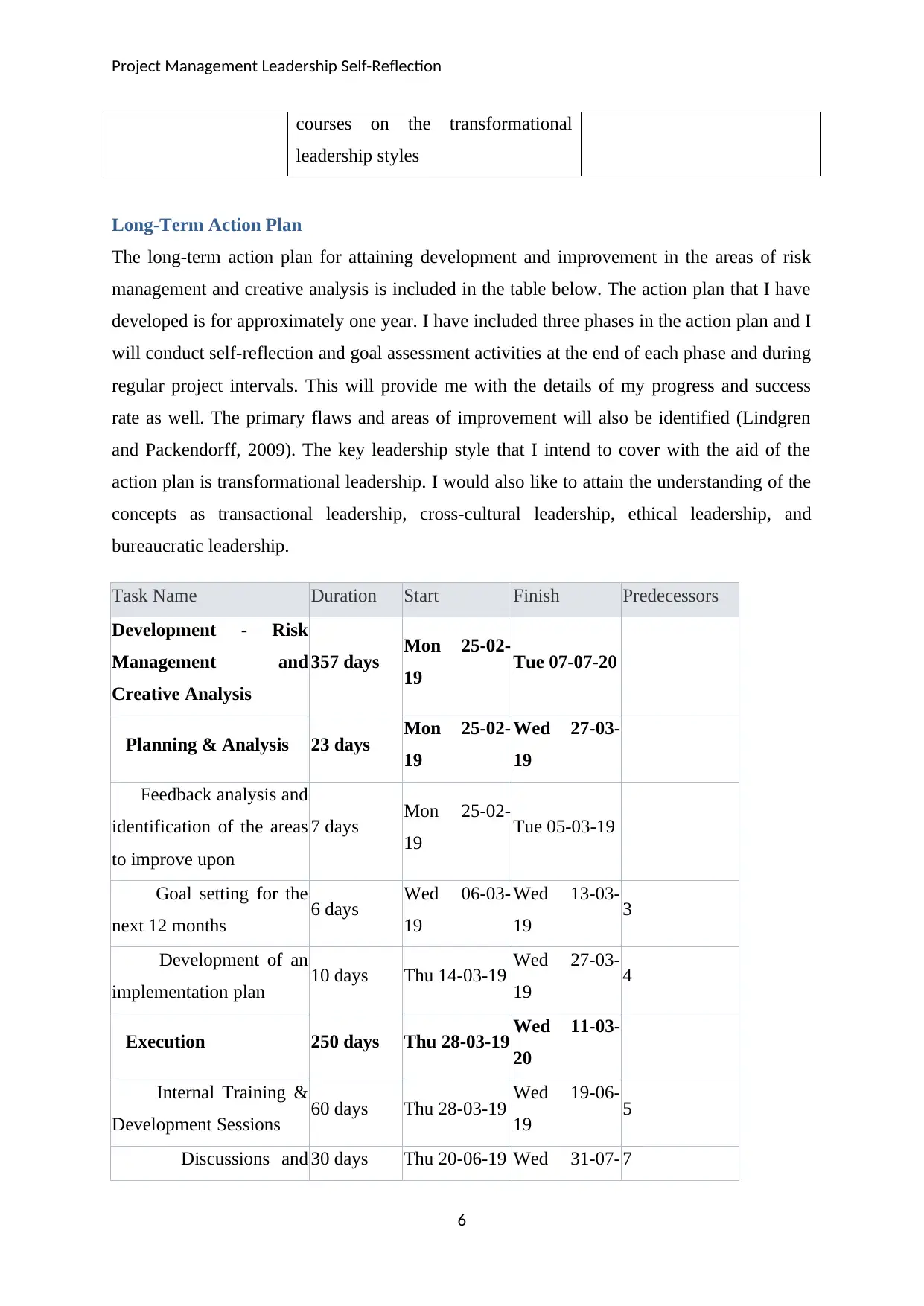
Project Management Leadership Self-Reflection
courses on the transformational
leadership styles
Long-Term Action Plan
The long-term action plan for attaining development and improvement in the areas of risk
management and creative analysis is included in the table below. The action plan that I have
developed is for approximately one year. I have included three phases in the action plan and I
will conduct self-reflection and goal assessment activities at the end of each phase and during
regular project intervals. This will provide me with the details of my progress and success
rate as well. The primary flaws and areas of improvement will also be identified (Lindgren
and Packendorff, 2009). The key leadership style that I intend to cover with the aid of the
action plan is transformational leadership. I would also like to attain the understanding of the
concepts as transactional leadership, cross-cultural leadership, ethical leadership, and
bureaucratic leadership.
Task Name Duration Start Finish Predecessors
Development - Risk
Management and
Creative Analysis
357 days Mon 25-02-
19 Tue 07-07-20
Planning & Analysis 23 days Mon 25-02-
19
Wed 27-03-
19
Feedback analysis and
identification of the areas
to improve upon
7 days Mon 25-02-
19 Tue 05-03-19
Goal setting for the
next 12 months 6 days Wed 06-03-
19
Wed 13-03-
19 3
Development of an
implementation plan 10 days Thu 14-03-19 Wed 27-03-
19 4
Execution 250 days Thu 28-03-19 Wed 11-03-
20
Internal Training &
Development Sessions 60 days Thu 28-03-19 Wed 19-06-
19 5
Discussions and 30 days Thu 20-06-19 Wed 31-07- 7
6
courses on the transformational
leadership styles
Long-Term Action Plan
The long-term action plan for attaining development and improvement in the areas of risk
management and creative analysis is included in the table below. The action plan that I have
developed is for approximately one year. I have included three phases in the action plan and I
will conduct self-reflection and goal assessment activities at the end of each phase and during
regular project intervals. This will provide me with the details of my progress and success
rate as well. The primary flaws and areas of improvement will also be identified (Lindgren
and Packendorff, 2009). The key leadership style that I intend to cover with the aid of the
action plan is transformational leadership. I would also like to attain the understanding of the
concepts as transactional leadership, cross-cultural leadership, ethical leadership, and
bureaucratic leadership.
Task Name Duration Start Finish Predecessors
Development - Risk
Management and
Creative Analysis
357 days Mon 25-02-
19 Tue 07-07-20
Planning & Analysis 23 days Mon 25-02-
19
Wed 27-03-
19
Feedback analysis and
identification of the areas
to improve upon
7 days Mon 25-02-
19 Tue 05-03-19
Goal setting for the
next 12 months 6 days Wed 06-03-
19
Wed 13-03-
19 3
Development of an
implementation plan 10 days Thu 14-03-19 Wed 27-03-
19 4
Execution 250 days Thu 28-03-19 Wed 11-03-
20
Internal Training &
Development Sessions 60 days Thu 28-03-19 Wed 19-06-
19 5
Discussions and 30 days Thu 20-06-19 Wed 31-07- 7
6
Paraphrase This Document
Need a fresh take? Get an instant paraphrase of this document with our AI Paraphraser
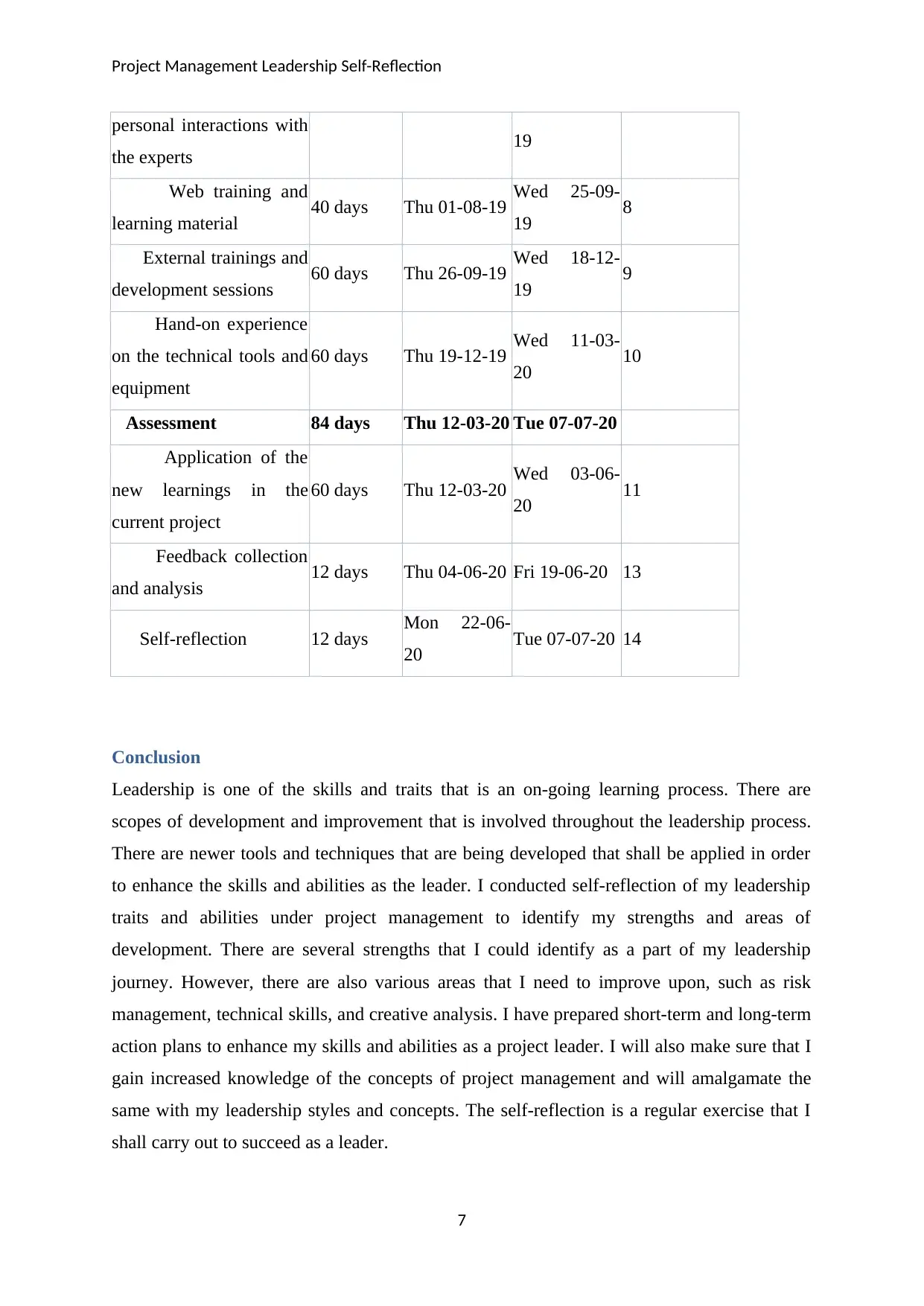
Project Management Leadership Self-Reflection
personal interactions with
the experts 19
Web training and
learning material 40 days Thu 01-08-19 Wed 25-09-
19 8
External trainings and
development sessions 60 days Thu 26-09-19 Wed 18-12-
19 9
Hand-on experience
on the technical tools and
equipment
60 days Thu 19-12-19 Wed 11-03-
20 10
Assessment 84 days Thu 12-03-20 Tue 07-07-20
Application of the
new learnings in the
current project
60 days Thu 12-03-20 Wed 03-06-
20 11
Feedback collection
and analysis 12 days Thu 04-06-20 Fri 19-06-20 13
Self-reflection 12 days Mon 22-06-
20 Tue 07-07-20 14
Conclusion
Leadership is one of the skills and traits that is an on-going learning process. There are
scopes of development and improvement that is involved throughout the leadership process.
There are newer tools and techniques that are being developed that shall be applied in order
to enhance the skills and abilities as the leader. I conducted self-reflection of my leadership
traits and abilities under project management to identify my strengths and areas of
development. There are several strengths that I could identify as a part of my leadership
journey. However, there are also various areas that I need to improve upon, such as risk
management, technical skills, and creative analysis. I have prepared short-term and long-term
action plans to enhance my skills and abilities as a project leader. I will also make sure that I
gain increased knowledge of the concepts of project management and will amalgamate the
same with my leadership styles and concepts. The self-reflection is a regular exercise that I
shall carry out to succeed as a leader.
7
personal interactions with
the experts 19
Web training and
learning material 40 days Thu 01-08-19 Wed 25-09-
19 8
External trainings and
development sessions 60 days Thu 26-09-19 Wed 18-12-
19 9
Hand-on experience
on the technical tools and
equipment
60 days Thu 19-12-19 Wed 11-03-
20 10
Assessment 84 days Thu 12-03-20 Tue 07-07-20
Application of the
new learnings in the
current project
60 days Thu 12-03-20 Wed 03-06-
20 11
Feedback collection
and analysis 12 days Thu 04-06-20 Fri 19-06-20 13
Self-reflection 12 days Mon 22-06-
20 Tue 07-07-20 14
Conclusion
Leadership is one of the skills and traits that is an on-going learning process. There are
scopes of development and improvement that is involved throughout the leadership process.
There are newer tools and techniques that are being developed that shall be applied in order
to enhance the skills and abilities as the leader. I conducted self-reflection of my leadership
traits and abilities under project management to identify my strengths and areas of
development. There are several strengths that I could identify as a part of my leadership
journey. However, there are also various areas that I need to improve upon, such as risk
management, technical skills, and creative analysis. I have prepared short-term and long-term
action plans to enhance my skills and abilities as a project leader. I will also make sure that I
gain increased knowledge of the concepts of project management and will amalgamate the
same with my leadership styles and concepts. The self-reflection is a regular exercise that I
shall carry out to succeed as a leader.
7
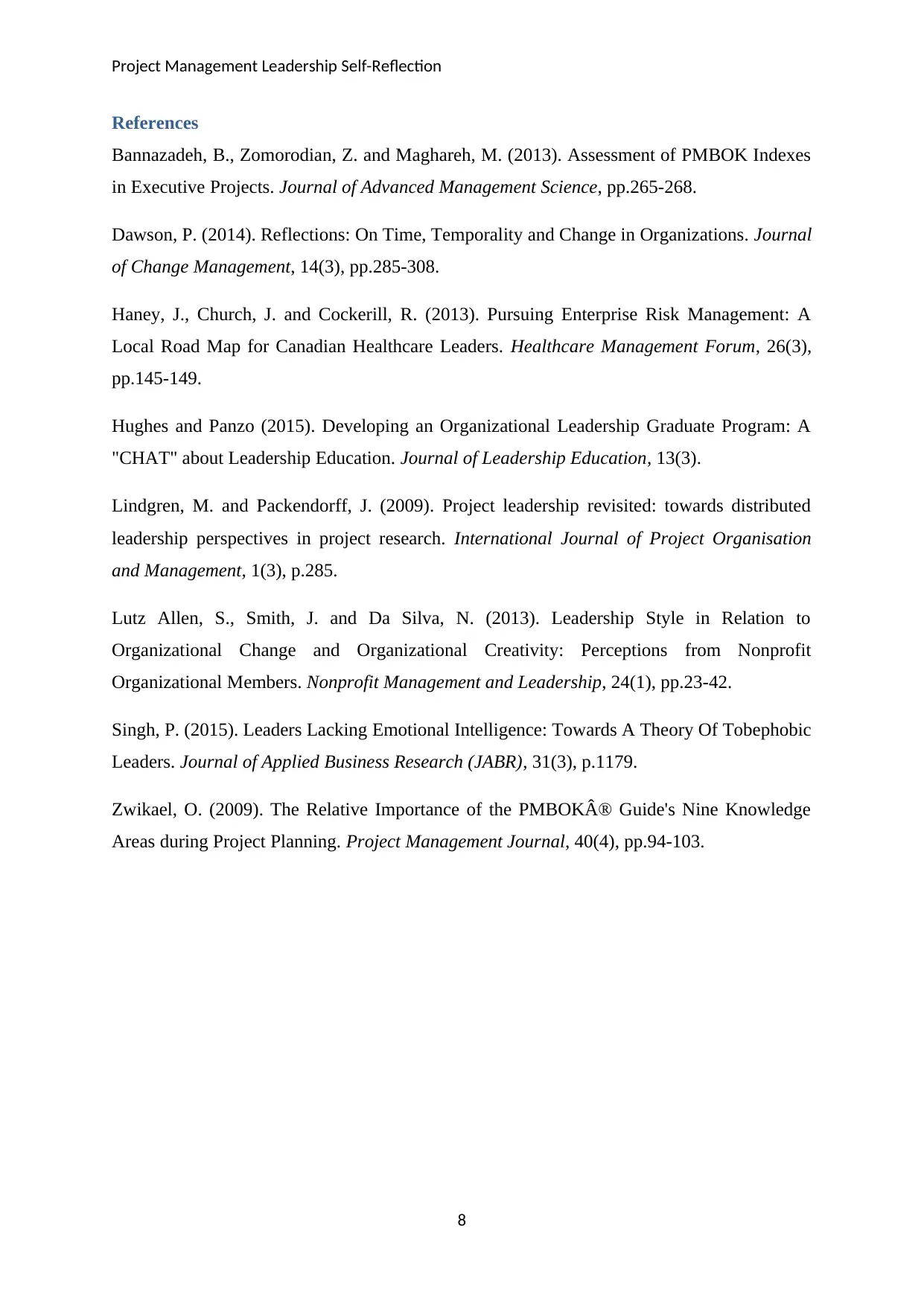
Project Management Leadership Self-Reflection
References
Bannazadeh, B., Zomorodian, Z. and Maghareh, M. (2013). Assessment of PMBOK Indexes
in Executive Projects. Journal of Advanced Management Science, pp.265-268.
Dawson, P. (2014). Reflections: On Time, Temporality and Change in Organizations. Journal
of Change Management, 14(3), pp.285-308.
Haney, J., Church, J. and Cockerill, R. (2013). Pursuing Enterprise Risk Management: A
Local Road Map for Canadian Healthcare Leaders. Healthcare Management Forum, 26(3),
pp.145-149.
Hughes and Panzo (2015). Developing an Organizational Leadership Graduate Program: A
"CHAT" about Leadership Education. Journal of Leadership Education, 13(3).
Lindgren, M. and Packendorff, J. (2009). Project leadership revisited: towards distributed
leadership perspectives in project research. International Journal of Project Organisation
and Management, 1(3), p.285.
Lutz Allen, S., Smith, J. and Da Silva, N. (2013). Leadership Style in Relation to
Organizational Change and Organizational Creativity: Perceptions from Nonprofit
Organizational Members. Nonprofit Management and Leadership, 24(1), pp.23-42.
Singh, P. (2015). Leaders Lacking Emotional Intelligence: Towards A Theory Of Tobephobic
Leaders. Journal of Applied Business Research (JABR), 31(3), p.1179.
Zwikael, O. (2009). The Relative Importance of the PMBOK® Guide's Nine Knowledge
Areas during Project Planning. Project Management Journal, 40(4), pp.94-103.
8
References
Bannazadeh, B., Zomorodian, Z. and Maghareh, M. (2013). Assessment of PMBOK Indexes
in Executive Projects. Journal of Advanced Management Science, pp.265-268.
Dawson, P. (2014). Reflections: On Time, Temporality and Change in Organizations. Journal
of Change Management, 14(3), pp.285-308.
Haney, J., Church, J. and Cockerill, R. (2013). Pursuing Enterprise Risk Management: A
Local Road Map for Canadian Healthcare Leaders. Healthcare Management Forum, 26(3),
pp.145-149.
Hughes and Panzo (2015). Developing an Organizational Leadership Graduate Program: A
"CHAT" about Leadership Education. Journal of Leadership Education, 13(3).
Lindgren, M. and Packendorff, J. (2009). Project leadership revisited: towards distributed
leadership perspectives in project research. International Journal of Project Organisation
and Management, 1(3), p.285.
Lutz Allen, S., Smith, J. and Da Silva, N. (2013). Leadership Style in Relation to
Organizational Change and Organizational Creativity: Perceptions from Nonprofit
Organizational Members. Nonprofit Management and Leadership, 24(1), pp.23-42.
Singh, P. (2015). Leaders Lacking Emotional Intelligence: Towards A Theory Of Tobephobic
Leaders. Journal of Applied Business Research (JABR), 31(3), p.1179.
Zwikael, O. (2009). The Relative Importance of the PMBOK® Guide's Nine Knowledge
Areas during Project Planning. Project Management Journal, 40(4), pp.94-103.
8
⊘ This is a preview!⊘
Do you want full access?
Subscribe today to unlock all pages.

Trusted by 1+ million students worldwide
1 out of 9
Related Documents
Your All-in-One AI-Powered Toolkit for Academic Success.
+13062052269
info@desklib.com
Available 24*7 on WhatsApp / Email
![[object Object]](/_next/static/media/star-bottom.7253800d.svg)
Unlock your academic potential
Copyright © 2020–2025 A2Z Services. All Rights Reserved. Developed and managed by ZUCOL.





